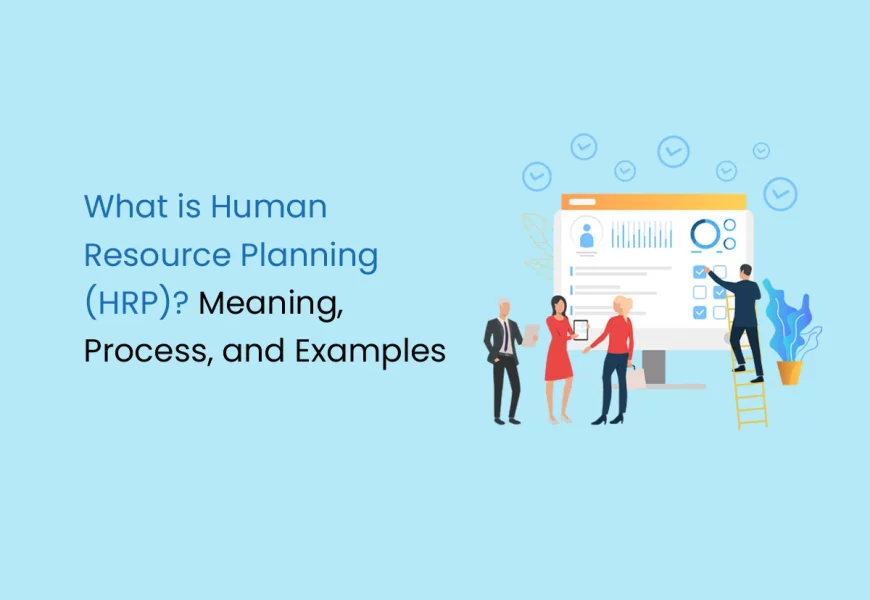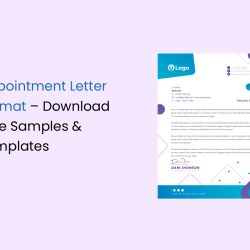Human resource planning (HRP) is crucial for organisations to understand their staffing needs. It involves identifying a business’s current and future requirements to achieve its goals effectively. Human Resource Planning is based on the economic principles of supply and demand and ensures that a company has the appropriate workforce to meet its needs. This process is also referred to as workforce planning.
This blog delves into human resource planning, its importance, features and the human resource planning process.
What is Human Resource Planning?
Human Resource Planning involves assessing a business’s human resource needs and devising strategies to fulfil them. It aims to ensure a harmonious human resource distribution and alleviate shortages or surpluses. In essence, Human Resources Planning assists companies in predicting future staffing needs and deciding how to allocate existing resources to achieve their objectives. It transforms the organisation’s goals into workforce size and skill level estimates.
A well-designed Human Resource Planning process helps optimise staff utilisation while preventing shortages. It functions as a roadmap for managing the current workforce and planning for future needs. This process is crucial for aligning organisational goals with resource allocation and ultimately determining the organisation’s success.
Importance of Human Resource Planning
Some of the reasons human resource planning is important are as follows:
- Enhancing Employee Value: HRP involves evaluating current employees and their skill sets and identifying any training requirements to help them develop new skills. This can help businesses reduce recruitment expenses and cultivate employee development and commitment.
- Facilitates the Organisation’s Adapt to Industry Shifts: Organisations can use HRP to predict shifts in talent requirements and industry trends proactively. This strategic approach enables businesses to smoothly navigate changes in job roles and allocate resources for new positions, particularly when targeting specialised market segments.
- Enhances a Competitive Edge: HRP enables organisations to make well-informed choices about hiring and training, considering employee preferences, work-life balance, and other appealing job attributes.
- Aids Long-Term Growth: HR professionals use HRP to anticipate future hiring needs, departmental growth, and potential retirements. This proactive strategy helps budget for upcoming hiring needs and ensures a balanced and optimal workforce size.
Evolution of Human Resource Planning
The study of the history and evolution of Human Resource Planning (HRP) provides valuable insights into its foundational principles, roles, and methodologies across different periods. This understanding is crucial in shaping effective HRP strategies for the modern workplace.
The term ‘Human Resource Planning’ is relatively recent. Historically, the production of goods and services was often controlled by the same individuals, resulting in fewer employer-employee conflicts. However, as industrialisation expanded, new challenges in managing human resources emerged.
This section examines the evolution of HRP through various periods:
HRP as a Science: Before 1900
The origins of modern human resource management and planning can be traced back to the early 19th century, when Robert Owen was recognised as a key figure. Owen championed better industrial relations, improved working conditions, and the eradication of child labour. His contemporaries, such as J.S. Mill and Andrew Yule, further developed HRM as a scientific discipline, advocating for wage incentives and labour welfare measures.
Focus on Efficiency and Productivity: 1900-1920
Between 1900 and 1920, there was a strong focus on improving efficiency and productivity, particularly through scientific management principles introduced by Frederick Taylor. This era saw the expansion of large organisations, the rise of scientific job analysis, and enhanced worker selection and training processes. Taylor’s approach emphasised a mental shift towards greater work discipline, though it was often at odds with workers’ unions.
Welfare Focus and Industrial Psychology:1920-1930
During the 1920s, the field of Human Resource Management began to formalise with the creation of staff line organisations. In response to the opposition to Taylor’s scientific management, industrial psychology gained prominence, introducing psychological testing, interviews, worker training, and non-financial incentives. This professionalised HR planning and transformed it into a distinct and specialised area of management.
The Modern Age: After 1950
The period from 1950 to 1970 marked a shift in HRM towards a focus on workers’ rights and industrial democracy. HR managers took on greater responsibilities, and the discipline of HRM began to be widely accepted as a distinct and crucial field in managing the workforce.
Behavioural Science and Open Systems: After 1970
Post-1970, HRM underwent further transformation, evolving into a behavioural science that placed greater emphasis on the human aspect and organisational behaviour. The concept of ‘open social and industrial systems’ gained traction, firmly establishing HRM as a professional discipline. Its scope continued to expand, solidifying its role in managing human resources within increasingly complex organisations.
Features of Human Resources Planning
Here are the key features of human resource planning:
- Increased Productivity: HRP prioritises maximising productivity by effectively using resources and reducing waste. This involves ensuring that employees are skilled, motivated, and fairly compensated. Initiatives such as training, performance appraisals, and equitable compensation practices are implemented to drive productivity. Well-prepared and motivated employees are more efficient and contribute substantially to productivity.
- Implementing Managerial Activities: The success of managerial functions such as planning, organising, directing, and controlling depends on having the right individuals in the right positions. HRP ensures that the organisation possesses the required human resources to carry out these functions effectively. Having competent individuals in suitable roles facilitates seamless operations and improves the efficiency of managerial activities.
- Motivating Employees: In addition to overseeing staffing needs, HRP significantly impacts employee motivation through incentive programs. These programs are crafted to stimulate active involvement and promote long-term retention within the company. Effective HRP includes creating and implementing reward systems that engage and motivate employees, leading to a productive and committed workforce.
- Improving Employee Relations: HRP is pivotal in achieving solid human relationships by facilitating clear communication, effective control, and strong managerial leadership. HRP helps nurture a cooperative and competent workforce by implementing targeted training and development programs. This fosters a positive work environment where employees comprehend their responsibilities, communicate proficiently, and collaborate effectively.
- Coping with Change: HRP provides businesses with the strategies and tools to effectively navigate the rapidly changing business landscape, improving employee and organisational performance. HRP helps organisations navigate market fluctuations, technological advancements, and other external factors with agility and effectiveness by proactively anticipating future needs and aligning resources accordingly.
- Evaluating Demand and Supply of Resources: HRP is a detailed assessment of an organisation’s human resources demand and supply. Its main goal is to maintain an ideal balance of employees, preventing both overstaffing and understaffing, essential for sustaining operational efficiency.
- Increasing Quality of Hire: Effective HRP impacts the quality of hires. Effective HR planning allows organisations to pinpoint the specific qualities and skills required in candidates, leading to more precise and successful hiring choices. This ultimately helps draw in candidates who are an excellent fit for the organisation’s requirements.
- Growing a Competitive Advantage: HRP is crucial in recognising and developing top talent, giving organisations a competitive edge. HRP allows companies to adjust rapidly, innovate successfully, and offer exceptional products and services by ensuring that individuals with the appropriate skills are placed in suitable roles.
Human Resource Planning Process
The process of human resource planning is as follows:
Analysing Business Objectives
Effective HRP hinges on its alignment with the business’s goals and objectives. The initial step in human resource planning involves establishing HR goals based on the organisation’s future aspirations and the means to achieve them.
Since each department within an organisation has distinct objectives and human resource needs, HR professionals collaborate with management to assess their human capital requirements. For example, certain departments may expand and necessitate more staff, while others may undergo downsizing. Human resource planning facilitates the redistribution of resources from the latter to the former.
Assessing the Current Workforce
When developing a human resource strategy for the future, it is essential to start with a thorough evaluation of the current workforce. Understanding how employees are distributed across departments, teams, and positions is also crucial. It is also important to gain insight into each employee’s skills, competencies, and experience, including their skill sets, expertise, and years of experience. Considering the age demographics of the workforce is also important.
This information can be gathered from the existing HR database. Supplementing this data with insights from performance appraisals and reviews can provide a more comprehensive understanding. Visual tools can map out the workforce based on individual roles, designations, and hierarchies, offering a comprehensive overview. This approach also assists in linking each employee to their training, skills, and expertise levels, thereby aiding in succession planning and talent development.
Forecasting Demand and Requirements
When planning for future workforce needs, organisations should start by assessing the skills of their current employees and then forecasting the demand and skill requirements. This involves analysing organisational goals, evaluating the existing workforce’s strength, and using the data collected to predict the business demand. It’s essential to consider factors such as whether the organisation needs more employees, the type of employees to hire (full-time, part-time, or freelancers), and whether the organisation is fully utilising the potential of its existing employees. It’s also essential to assess the availability of skilled resources in the labour market and to determine whether employees need further training to meet changing needs. Finally, when estimating workforce needs, organisations should consider external factors such as industry trends, labour costs, automation prospects, new products, employee turnover rates, and employee retirement.
The following techniques to estimate the workforce demand:
- GAP Analysis: This analysis helps compare the skills and competencies of the existing workforce with the business goals and estimate the gap between the two.
- SWOT Analysis: It involves evaluating the existing strengths, weaknesses, opportunities and threats to identify the areas that need improvement to align with business goals.
- Scenario Planning: It involves evaluating various possibilities and estimating the workforce requirements accordingly. It considers technological evolution and economic impact and evaluates the skill and workforce requirements under each scenario.
Design an Action Plan
When estimating workforce requirements, it’s essential to develop an action plan. If there’s a shortage, consider hiring new resources, training existing employees, or transferring from areas with a surplus. Conversely, if there’s a surplus, explore transfers, layoffs, and other measures to reduce costs.
An action plan guides an organisation from its current state to its desired state. It should include strategies and pathways aligned with the organisation’s goals and objectives.
Action plans vary based on organisational needs. For instance, startups and small businesses facing a shortage may focus on training existing employees, while larger enterprises prioritise hiring strategies. During this process, organisations concentrate on hiring, training, education, performance management and organisational culture. Once the action plan is finalised, it’s crucial to communicate the details to all employees in the organisation.
Monitor and Review the Plan Periodically
When an action plan for workforce optimisation is rolled out, periodic evaluations are crucial to assess the effectiveness of the human resource planning strategies. This involves reviewing employee retention rates and engagement levels to identify potential areas for improvement. Performance reviews and employee surveys are useful tools to gain insights into the effectiveness of the action plan. Based on the feedback received, adjustments to the action plan should be made as necessary, and if needed, starting over from scratch should be considered.
Benefits of Human Resource Planning
Some of the benefits of human resource planning:
- Talent Management: HRP is essential for organisations to effectively manage their talent and human capital. This process involves identifying top-performing individuals in the workforce and providing professional development and growth opportunities. By recognising and nurturing star performers, an organisation can greatly enhance its overall value while also contributing to its employees’ personal and career advancement.
- Training and Development: Effective HR planning is essential for businesses as it enables them to pinpoint any skill deficiencies within the organisation. Companies can ensure that their employees receive the required training and support by engaging in HR planning. This undertaking doesn’t just bolster the business’s overall productivity but is a pivotal factor in maintaining high employee engagement and motivation levels.
- Manage Human Resource Costs: HRP is critical in helping organisations strategically manage their workforce and minimise talent management costs. Organisations can gain valuable insights into the ideal number of employees needed to meet current and future business demands through effective planning. This enables them to reduce unnecessary expenses related to excess staffing while ensuring they have the right talent.
- Promotes Employee Retention: Organisations must engage in effective HRP to strategically manage their workforce and foster a positive and inclusive workplace culture. By understanding and responding to employees’ needs and expectations, HR planning can improve job satisfaction, increasing morale and productivity. This can positively impact employee retention rates and create a sustainable and thriving work environment.
- Mitigate Risks and Uncertainties: HRP involves a strategic approach that allows organisations to evaluate and reduce potential risks associated with recruiting, deploying, and managing their personnel. It entails predicting future needs and challenges, enabling organisations to address external factors like labour shortages and legislative changes proactively. This proactive approach allows organisations to anticipate and prepare for potential challenges.
- Conformity to Regional Compliance: In human resource management, it’s crucial to recognise that labour laws vary from one region to another. These laws are regularly updated and modified, necessitating organisations to keep up with these changes. HRP keeps the HR policy in line with the current legal framework in each region by reviewing and adapting to evolving norms for compliance.
- Strategic Workforce Planning: HRP helps organisations strategically prepare for succession and career advancement opportunities. Through thorough planning, businesses can adeptly manage internal disruptions that may occur when employees leave the organisation, whether due to retirement or resignation. It enables companies to identify and develop potential successors, promoting a seamless transition and uninterrupted operations.
- Align Human Capital With Business Goals: HRP is a process that involves aligning an organisation’s human resources with By strategically preparing for employee recruitment, development, and retention, companies can ensure their workforce is well-equipped to contribute significantly to achieving organisational targets. When a team prioritises human resource planning, it can optimise talent utilisation, promote collaboration, and propel the organisation towards reaching its objectives more effectively and efficiently.
Challenges in Human Resource Planning
Here are the key challenges in human resource planning:
- Finding a Skilled Labour Force: Recruiting and retaining a skilled workforce is one of the main hurdles in HRP. The demanding nature of the business environment intensifies this challenge, creating obstacles in identifying and engaging top talent. Any recruitment delays can adversely affect HRP outcomes, resulting in a misalignment between the workforce’s skills and the organisation’s requirements.
- Inaccurate Demand Forecasts: Predicting workforce demand relies on the objectives, needs and capabilities of the organisation’s existing workforce. Incorrect information can result in unreliable predictions, impacting the entire HRP. Biases and subjective assessments can also distort the outcomes. Implementing reliable HRIS systems can improve the precision of demand forecasts by offering dependable data and analytical insights.
- Technological Advancements: The rapidly changing technological environment presents a major challenge for HRP. Advancements in automation and technology can make current skills irrelevant, necessitating ongoing adjustments to workforce planning approaches. Organisations must consider external technological developments and internal factors to anticipate future workforce requirements and remain adaptable.
- Time Horizon: Predicting future workforce needs becomes more challenging over longer time horizons due to growing uncertainty. Unforeseen events and changes can disrupt plans, making it crucial for HRP to be an ongoing process with regular updates to align with current realities and future projections.
Tools Used in Human Resources Planning
HR professionals can use the following tools for human resource planning:
Business Environment Analysis
The following tools can help HR professionals analyse the environment:
- Government Data and Economic Indicators: The external environment impacts both businesses and individual employees. HR professionals can use economic metrics such as inflation and employment rates to make data-driven decisions. Information on these external factors is publicly available on portals such as the Indian Government Data Portal and the Ministry of Statistics Portal.
- Industry Reports and Market Research: Valuable insights can be obtained from reports and research from private agencies such as Nielsen and Gartner. Industry reports from renowned agencies like McKinsey & Co. and Deloitte offer valuable information. Additionally, a popular website, Market Research, provides important insights into market conditions.
Labour Requirement Analysis
Here are some ways to assess the workforce:
- Work Breakdown Structure (WBS): It is a project management tool that breaks down a project into smaller, more manageable tasks. By estimating the time and effort required for each task, the total labour needed for a project can be better estimated.
- Time and Motion Studies: Time and motion studies analyse the time it takes for individual workers to complete specific tasks. Companies can streamline workflow and establish the right staffing levels by scrutinising these movements.
- Industry Benchmarks: When determining staffing needs, it’s important to consider industry benchmarks. Looking into how similar companies manage their workforce can provide the company with a starting point for its labour requirements. Adjustments can be made based on the unique demands of specific projects or production volumes.
- Experience-Based Estimates: One method for estimating project labour requirements is using experience-based estimates. This involves leveraging the experience of managers, and project leads to estimate the labour needed for similar projects.
- Scenario Planning: When considering future conditions, such as increased production demands or technological advancements, scenario planning can be utilised to forecast labour needs. This allows the workforce to better adapt to changing circumstances.
Current Labour Condition
Some ways that HR professionals can assess current labour conditions are as follows:
- Surveys and Focus Groups: Gathering employee feedback through surveys and focus groups provides valuable insights into their engagement, satisfaction, skills gaps, and overall well-being. This helps in understanding employee morale and identifying areas for improvement.
- Performance Reviews and Feedback: Performance reviews and feedback sessions are conducted regularly to help managers evaluate individual and team performance. This process helps identify employee strengths and areas where they may need support, offering valuable insights into the skills and development needs of the workforce.
- Employee Engagement Metrics: Measuring employee engagement is essential for understanding the satisfaction and dedication of the workforce. Keeping track of metrics such as turnover rates, absenteeism, and employee Net Promoter Score (eNPS) can provide valuable insights into employee engagement and workforce satisfaction.
- Exit Interviews: It’s important to conduct exit interviews with departing employees as it helps in understanding the reasons for their departure. This can provide insights into potential company culture, workload, or compensation issues that may affect employee morale or retention.
Conclusion
Human resource planning is crucial for businesses as it effectively manages human capital allocation, optimises workforce productivity, reduces costs, enhances employee engagement, and helps mitigate the impact of uncertainties and risks. Identifying the right talent and skills within an organisation will help ensure that the right people are in the right positions, ultimately leading to improved job performance and morale.
Frequently Asked Questions
What is the scope of Human Resource Planning?
Human resource planning involves analysing an organisation's human resource needs in fluctuating conditions and creating strategies to fulfil those needs. This type of planning enables organisations to prepare for and effectively respond to changes in an organised and coordinated manner.
How does HR planning contribute to business growth?
HR planning can drive business growth in the following ways:
- Promote an efficient talent management strategy
- Improve employee engagement
- Enhance the productivity of different departments
- Make reliable forecasts about workforce demand
- Gain a competitive edge in the industry
- Reduce the cost of human capital
What are the best practices for HR planning during crises?
Some of the best practices for HR planning during unanticipated crises are as follows:
- Succession planning and promotion
- Human resource software
- Training and Education
- Reliable workforce demand
- Scale the workforce














